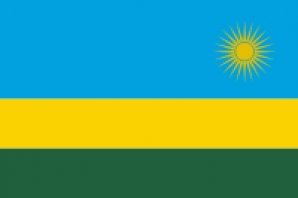ID : SHA8437537
Rwanda Environment Management Authority (REMA)
Rwanda Environment Management Authority (REMA)
Rwanda Environment Management Authority (REMA)


-
Name of the business / organization :Rwanda Environment Management Authority (REMA)
-
Country :Rwanda
-
Province :City of Kigali
-
District :Gasabo
-
Sector :Kacyiru
-
P.O. Box and City :7436, Kigali, Rwanda
-
Fixed telephone 1 :+250 252 580 101
-
Fax 1 :+ 250 252 580 017
-
Web site :
-
Business / Organization Brief Description :REMA is non-sectorial institution mandated to facilitate coordination and oversight of the implementation of national environmental policy and the subsequent legislation.
REMA has a key role to play towards the achievement of the national goal of sustainable development as set in out in the National Developement Vision 2020.
The alarming rate of environmental destruction as a result of population pressure, serious erosion, pressure on natural resources, massive deforestation, pollution in its various forms etc. necessitated the Government, to form REMA to coordinate, supervise and regulate environmental management for sustainable development in Rwanda.
To achieve its objectives, REMA has to work with and through public, private sector and civil societies. Thus, the structure of REMA must accommodate operational links at these levels in order to enhance service delivery to its stakeholders. REMA structure should be flexible enough in order to cope with various challenges at central, decentralized and international levels. Two types of environmental management functions below, have to be given thorough consideration in the process of preparing the structure of REMA:
Sectoral Environmental Management Functions relating to specific natural resources or environmental services such as agriculture, water, mining, forestry, waste management etc.
Coordination and integration of environmental management functions in relation to cross-cutting issues such as monitoring and evaluation of environmental policy and implementation of environmental legislation, these are a prelude of REMA.
REMA operates under the Ministry of Natural resources (MINIRENA),and is headed by the Director General who is responsible for the implementation of policy and framework legislation relating to environment.
REMA is governed by a Board of Directors comprising 7 people appointed by the Prime Minister on advice from the Minister responsible for Environment. The main responsibility of the Board is to ensure environmental policy and subsequent legislation are implemented, performance of the Authority is evaluated and budgets receive approval.
The final proposed organizational structure is built as follows;
Director General Office
Directorate Corporate Services
-
Products & Services :Mandates, roles and functions of REMA are clearly stipulated in the Law No 16/2006 of 03/04/2006 . Thus, the institutional structure for environmental management in Rwanda has to consider those functions and responsibilities along side with issues of concern listed below.
Inter-sectoral coordination
Linkages between local and central government.
Clear institutional linkages
Clarity of mandates to avoid conflicts.
Adequate private sector and civil society involvement.
Institutional capacity
Departments:
Environmental Regulation and Pollution Control
Research, Environmental planning and development
Environmental education and Mainstreaming
Climate change, and International obligations
login
- Public service (140)
- Hotels & accommodation (335)
- Restaurants, Bars, Cafés & Leisure (470)
- Travel, Tourism & Transport (203)
- Banking, Insurance & Finance (79)
- Lawyers, Legal Exeprts & Notaries (54)
- Professional Services (281)
-
- Audit, Accounting, Tax & Consulting Firms(28)
- External auditors (individual)(31)
- Accountants(9)
- Tax consultants(28)
- Internal & management control(0)
- Finance consultants(8)
- Strategy consultants(2)
- Management consultants(5)
- Business development consultants(6)
- Civil engineering consultants(22)
- Marketing & Advertising(12)
- Express & postal mail(1)
- Customs clearing agents(2)
- Graphic designers(32)
- Designers(1)
- IT consultants & specialists(20)
- Web designers, software developers, programmers & IT specialists(5)
- Printing offices and Photocopying(28)
- Public secretariat(9)
- Moving / removal contractors(27)
- Trade Associations (6)
- Health (297)
- Education - Public (63)
- Education - Private (70)
- Beauty and Wellness (282)
- Ceremonies, Parties and Events (156)
-
- Wedding (related items & services)(21)
- Halls & sites for meetings, receptions & parties(15)
- Tents , chairs & decoration material rental(93)
- Sound system equipments rental(9)
- Ceremony, event & traditional clothes / costumes rental(1)
- Wedding and event planners(4)
- MC (Masters of Cermonies)(2)
- Abakwe Bakuru & Abavuga Imisango(0)
- Traditional dance companies(4)
- Catering(0)
- Cooking chefs at home(0)
- Other reception, party and event equipments rental(0)
- Mobile toilets(1)
- Shopping, Clothing, Shoes, Jewelry & Accessories (337)
-
- Shopping centers & malls(2)
- Clothing, shoes & accessories stores - All(171)
- Clothing, shoes & accessories stores - Ladies(3)
- Clothing, shoes & accessories stores - Men(0)
- Clothing, shoes & accessories stores - Kids(14)
- Jewelry(28)
- Shoes shops(11)
- Working clothes - making & sale(2)
- Textile / cloth printing & embroidery(8)
- Clothing fabrics(4)
- Tailors & fashion designers(87)
- Home, Office & Shop Furniture, Equipments, Decoration & Accessories (218)
- Computers, Telephones, Sound, Television, Internet, Electronics & other ICT (181)
- Food and Beverages (270)
- Craft Industry (84)
- Arts, Culture & Entertainment (100)
-
- Singer artists(0)
- Musical instrument players(0)
- Songwriters(0)
- Music producers & recording studios(2)
- Music schools and teachers(0)
- Live music bands(0)
- Non religious choirs(0)
- DJ (Disc Jockeys)(0)
- Traditional music(0)
- Movie script writers(0)
- Movie / film producers(3)
- Movie actors(0)
- Film / movie directors(0)
- Photographers, Cameramen, Photo & Video Studios(34)
- Cinema studios(0)
- Cinemas / movie theaters(0)
- Cinema and photo schools(0)
- Playwrighters(0)
- Playwright producers(0)
- Stage actors(0)
- Stage directors(0)
- Theater companies(0)
- Stage arts schools(0)
- Dancing lessons & schools(0)
- Theater, show, concert halls, rooms & sites(0)
- Comedy artists(0)
- Painting artists(0)
- Sculptor artists(0)
- Pastic arts schools(0)
- Artists managers(0)
- Art galleries(20)
- Edition & Publishing(3)
- Newspapers & Magazines(10)
- Journalists(0)
- Radio & television stations(16)
- Radio & television shows producers & presenters(0)
- Writers(0)
- Bookshops(5)
- Libraries(5)
- Museums(0)
- Construction, Real Estate & House (353)
-
- Construction companies / contractors(10)
- Real estate promoters / developers(2)
- Real estate offices(0)
- Architects(7)
- Construction engineers(2)
- Land surveyors & topographers(2)
- Quantity surveyors(0)
- Construction site coordinators(0)
- Building maintenance(0)
- Property managers(4)
- Real property valuers & real estate consultants(44)
- Real estate brokers and commissionnaires(7)
- Hardware stores(224)
- Brics, cement blocs, concrete, sand, etc.(11)
- Air conditioning(2)
- Elevators & escalators(0)
- Glasses and window panes(2)
- Frames & carpenters(0)
- Doors and windows(0)
- Electricians(2)
- Plumbers(3)
- Builders / bricklayers(0)
- Welders(0)
- House painters(0)
- Joiners(0)
- Helpers in manual works(0)
- Gardeners(0)
- Paints dealers(20)
- Energy, Water, Environment & Nature (10)
- Security & Safety (3)
- Hygiene (56)
- Sports & Leisure (40)
- Cars, Motorbikes & Bikes (129)
-
- New cars sale(3)
- Used cars sale(0)
- Garages(24)
- Mechanics(0)
- Electro-mechanics(3)
- Car body repairers(0)
- Car painting(0)
- Car spare parts(54)
- Car rental - classic(3)
- Car rental - ceremonies & limousines(1)
- Trucks rental(3)
- Driving schools(25)
- Cars commissionnaires & brokers(0)
- Bikes & accessories stores(1)
- Tires sale & repair(10)
- Gasoline, diesel, bottled gas & other fuels(0)
- Factories, Workshops & Manufacturers (38)
- Agriculture (45)
- Animals & Breeding (47)
- Civil Associations & Society (6)
- Religion & Spirituality (11)
- NGOs (Non-Governmental Organizations) (2)
- Embassies & Cooperation (13)
- International organizations (19)
- Other category (22)




 Rwanda
Rwanda 
 18310
18310








